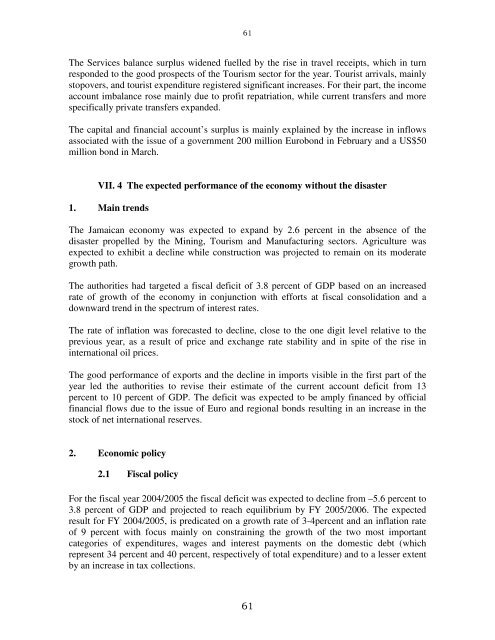Jamaica: Macro-Socio-Economic and Environmental Assessment of ...
Jamaica: Macro-Socio-Economic and Environmental Assessment of ...
Jamaica: Macro-Socio-Economic and Environmental Assessment of ...
You also want an ePaper? Increase the reach of your titles
YUMPU automatically turns print PDFs into web optimized ePapers that Google loves.
61<br />
The Services balance surplus widened fuelled by the rise in travel receipts, which in turn<br />
responded to the good prospects <strong>of</strong> the Tourism sector for the year. Tourist arrivals, mainly<br />
stopovers, <strong>and</strong> tourist expenditure registered significant increases. For their part, the income<br />
account imbalance rose mainly due to pr<strong>of</strong>it repatriation, while current transfers <strong>and</strong> more<br />
specifically private transfers exp<strong>and</strong>ed.<br />
The capital <strong>and</strong> financial account’s surplus is mainly explained by the increase in inflows<br />
associated with the issue <strong>of</strong> a government 200 million Eurobond in February <strong>and</strong> a US$50<br />
million bond in March.<br />
VII. 4 The expected performance <strong>of</strong> the economy without the disaster<br />
1. Main trends<br />
The <strong>Jamaica</strong>n economy was expected to exp<strong>and</strong> by 2.6 percent in the absence <strong>of</strong> the<br />
disaster propelled by the Mining, Tourism <strong>and</strong> Manufacturing sectors. Agriculture was<br />
expected to exhibit a decline while construction was projected to remain on its moderate<br />
growth path.<br />
The authorities had targeted a fiscal deficit <strong>of</strong> 3.8 percent <strong>of</strong> GDP based on an increased<br />
rate <strong>of</strong> growth <strong>of</strong> the economy in conjunction with efforts at fiscal consolidation <strong>and</strong> a<br />
downward trend in the spectrum <strong>of</strong> interest rates.<br />
The rate <strong>of</strong> inflation was forecasted to decline, close to the one digit level relative to the<br />
previous year, as a result <strong>of</strong> price <strong>and</strong> exchange rate stability <strong>and</strong> in spite <strong>of</strong> the rise in<br />
international oil prices.<br />
The good performance <strong>of</strong> exports <strong>and</strong> the decline in imports visible in the first part <strong>of</strong> the<br />
year led the authorities to revise their estimate <strong>of</strong> the current account deficit from 13<br />
percent to 10 percent <strong>of</strong> GDP. The deficit was expected to be amply financed by <strong>of</strong>ficial<br />
financial flows due to the issue <strong>of</strong> Euro <strong>and</strong> regional bonds resulting in an increase in the<br />
stock <strong>of</strong> net international reserves.<br />
2. <strong>Economic</strong> policy<br />
2.1 Fiscal policy<br />
For the fiscal year 2004/2005 the fiscal deficit was expected to decline from –5.6 percent to<br />
3.8 percent <strong>of</strong> GDP <strong>and</strong> projected to reach equilibrium by FY 2005/2006. The expected<br />
result for FY 2004/2005, is predicated on a growth rate <strong>of</strong> 3-4percent <strong>and</strong> an inflation rate<br />
<strong>of</strong> 9 percent with focus mainly on constraining the growth <strong>of</strong> the two most important<br />
categories <strong>of</strong> expenditures, wages <strong>and</strong> interest payments on the domestic debt (which<br />
represent 34 percent <strong>and</strong> 40 percent, respectively <strong>of</strong> total expenditure) <strong>and</strong> to a lesser extent<br />
by an increase in tax collections.<br />
61
















